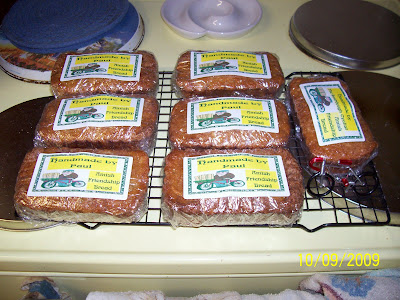I've had a dried Russian starter for awhile now but I havn't activated it since I've been wanting to make it a pure rye starter, getting fed only rye flour. Now that I had the rye flour it was time to play.
I started the Russian starter by first soaking 1 tablespoon of it in warm water in a small jelly mason jar. Think baby bottle wrist test warm. After it softened up I started feeding it one tablespoon of rye flour. The first two days of it's life it's feeding schedule was 1 tablespoon of warm water and rye flour twice a day, one in the morning while I was making coffee and once at night after I had all the dinner dishes done. On day 3 I noticed regular bubbling forming on the top of the starter so I increased the feedings to 1/2 cup of each after moving the start to a 1 quart plastic container whose previous live was holding soup from a take out Chinese food place. They make wonderful containers for left overs among other things. I have one that I use for just for rising small batches of starter and I have the outside marked in 1 cup increments up to two cups.
I've heard that this Russian starter is very active, thus good for dark heavy breads, but I wasn't ready for what I was about to witness. Verrrrrrry active stuff this Russian starter. After I was sure it was nice and fed, I threw one cup in its new home and put it in the fridge to rest while I took off for a 4 day weekend of cycling and camping.
Monday on my return I pulled it out of the fridge and fed it 1/2 cup of rye flour and warm water in my marked feeding container.
12 o'clock
12:30 pm
1 o'clock
1:30 pm

As you can see in the pictures, it was about ready to overflow the container in less than 2 hours.
The recipe I plan to use is a New York Deli style with sauted onions in it.
New York Deli Rye 2
2 cups proofed sourdough starter
1/2 cup chopped onions
1 tablespoon olive oil
2 tablespoons butter
1/4 cup water
1 teaspoon salt
2 cups rye flour
1 cup white bread flour
You may add 2 T. caraway seeds, if you wish...I did
To proof your starter, feed it with equal parts of flour and water, cover
loosely and let it sit overnight or up to 12 hours (longer proof=sourer flavor).
At this point, measure out your 2 cups of starter into mixing bowl and proceed
with recipe.
Saute onions in olive oil until they become translucent.
Remove from heat and add butter, water and salt.
Cool to lukewarm (85 degrees F) and stir into starter.
Add the rye flour and mix well.
Getting ready to mix it all up
Add the white flour gradually, until it is too stiff to mix by hand. I used very little of the white flour just using it to flour the work surface.
Turn onto a floured surface and knead in enough remaining flour until dough is satiny. This is a very sticky dough.
Place on baking sheet and let rise, covered, in a warm place for 1 to 2 hours,
or until about doubled in bulk (rising time will vary according to your starter,
but it takes longer than breads made with commercial yeast).
Preheat oven to 375 degrees F.
Make diagonal slashes in top of loaf with a razor blade or very sharp knife.
Bake for 40 to 50 minutes.
or until about doubled in bulk (rising time will vary according to your starter,
but it takes longer than breads made with commercial yeast).
This dough didn't rise much
Preheat oven to 375 degrees F.
Make diagonal slashes in top of loaf with a razor blade or very sharp knife.
Bake for 40 to 50 minutes.
The finished product
I had a slice with the spaghetti dinner I cooked tonight and although the bread wasn't very tall it was still very soft and moist with a great crust. The onion added a wonderful finishing flavor to it. I plan to try this one again soon and try it in a pan to see what it does.
Stay tuned.
Stay tuned.















































